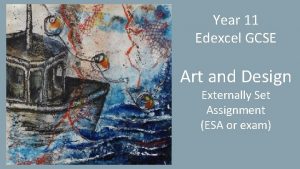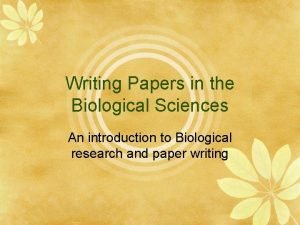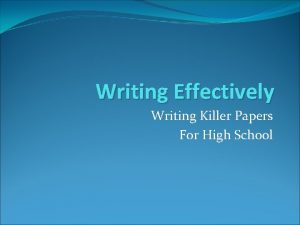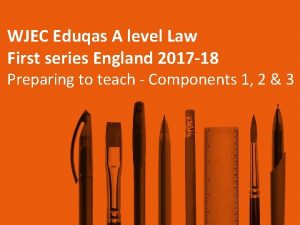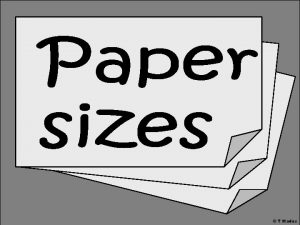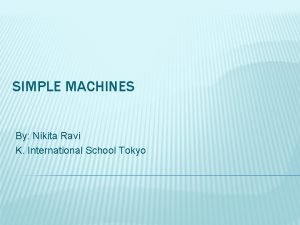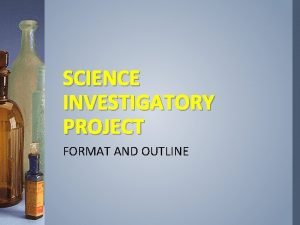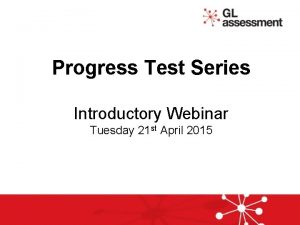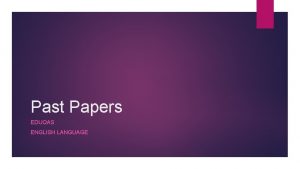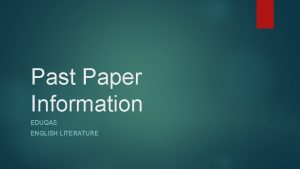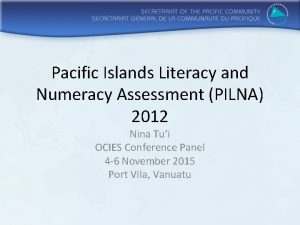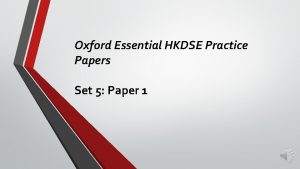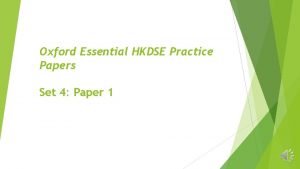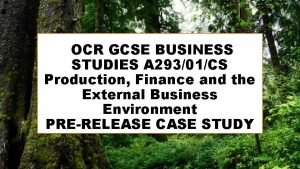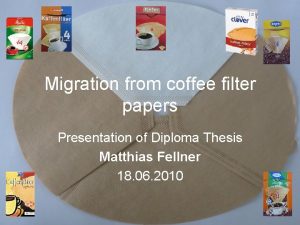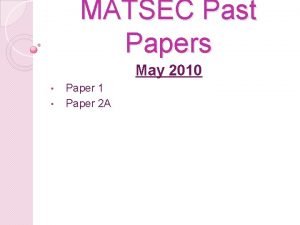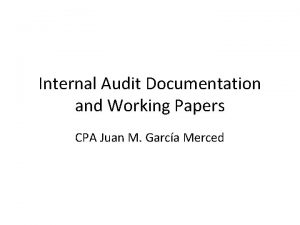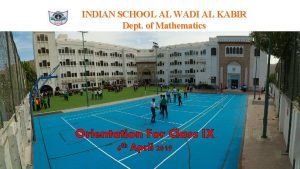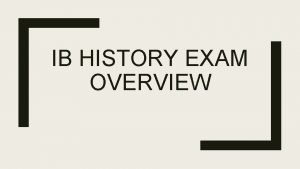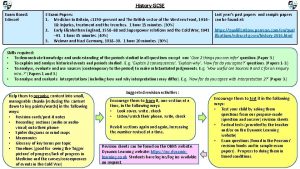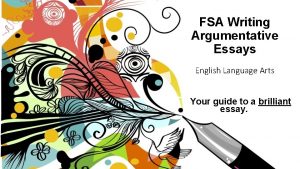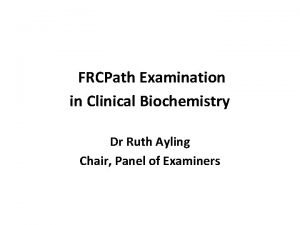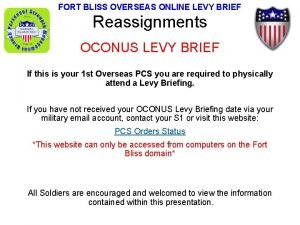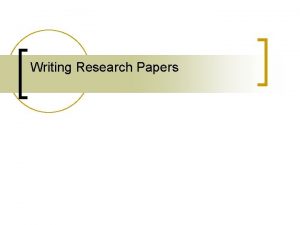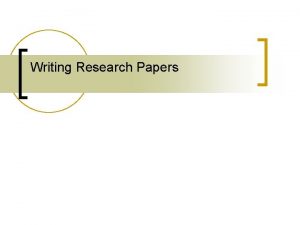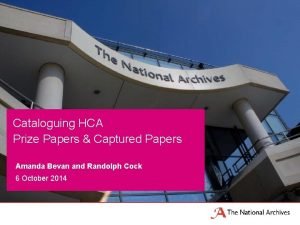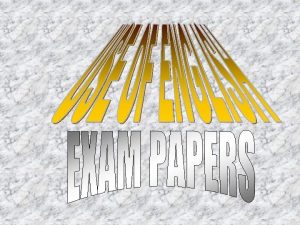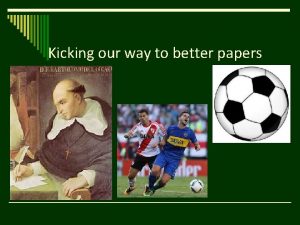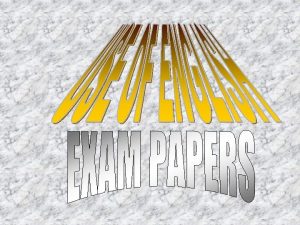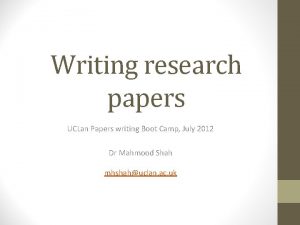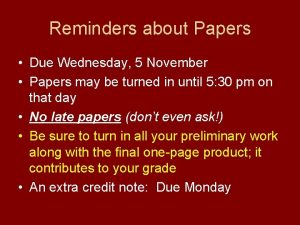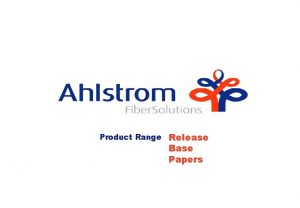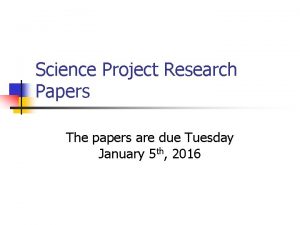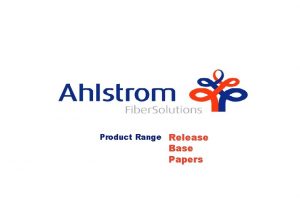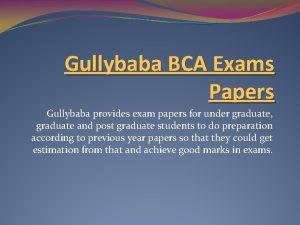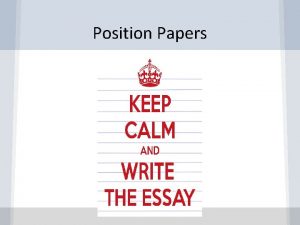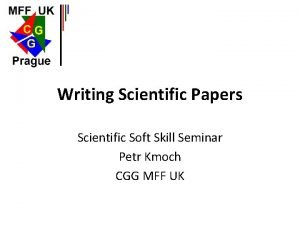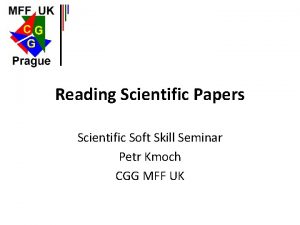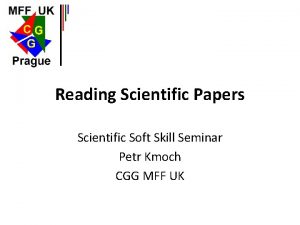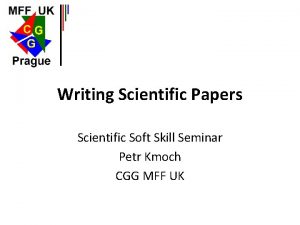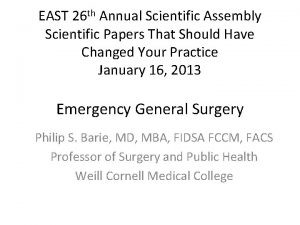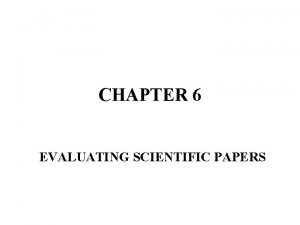Structure of Scientific Papers Structure of a Scientific
































- Slides: 32

Structure of Scientific Papers

Structure of a Scientific Paper • • • Title Page (title, authors, addresses, email, phone, sometimes keywords) Abstract Introduction Methods Results Discussion Acknowledgments References Tables List of Figures

TITLE Short (ideally < 12 words) Informative – accurately and precisely identifies focus of the paper • Topic/question addressed • Focal organism, habitat, etc. • Location (if particularly relevant)

Original title (27 words) A bayesian analysis of biological uncertainty for a whole-lake fertilization experiment for sockeye salmon in Chilko Lake, British Columbia, and implications for the benefit-cost ratio

Original title (27 words) A bayesian analysis of biological uncertainty for a whole-lake fertilization experiment for sockeye salmon in Chilko Lake, British Columbia, and implications for the benefit-cost ratio Revised title (12 words) Biological uncertainty of fertilization for sockeye salmon in Chilko Lake, British Columbia

AUTHORS First author: wrote the paper (may not have done the majority of the work) Other authors in order of contributions: all have made a significant intellectual contribution Final author: may be the head of the lab

AUTHORS Why is authorship important? • recognition in your profession (networking) • tenure and promotion are based on productivity • future grants are based on results and publications • intellectual property

Intellectual property UVM Intellectual Property Rights Policy: Includes, but is not limited to, “copyrightable books, whether fiction or non-fiction, manuscripts, poems, plays, choreography, photography, motion pictures, videos, audio recordings musical works, works of art or design, pedagogical works such as course materials, syllabi, lecture notes…” “Intellectual Property invented or created by (faculty, staff, students), shall remain the property of the individual” with exceptions relative to source of funding for the work Exception: “work made for hire” is work prepared by an employee within the scope of his or her employment and is not owned by that individual.

ACKNOWLEDGEMENTS People who contributed to accomplishing the work • technicians, lab and field assistants • captain, pilot, etc. • reviewers Funding agency Text is brief and impersonal • “We thank the following people for their assistance: ” • “The work was funded by…”

The study was funded by the Illinois Department of Natural Resources through Federal Aid in Sport Fish Restoration. We thank Rich Hess and Tom Trudeau for facilitating and assisting the project. We thank Phil Moy of the Army Corps of Engineers for his cooperation and assistance, and for his role in providing us with a multi-million dollar study site. Wayne Brofka, Chad Dolan, John Janssen, Tammy Keniry, Dan Makouskas, Steve Robillard, Jeff (“Sly”) Stein, and Kirby Wolfe assisted with field collections and diving. We thank Captain Dan Carlson for alerting us to the presence of lake trout spawning at the Port of Indiana breakwater.

The study was funded by the Illinois Department of Natural Resources through Federal Aid in Sport Fish Restoration. We thank Rich Hess and Tom Trudeau for facilitating and assisting the project. We thank Phil Moy of the Army Corps of Engineers for his cooperation and assistance, and for his role in providing us with a multi-million dollar study site. Wayne Brofka, Chad Dolan, John Janssen, Tammy Keniry, Dan Makouskas, Steve Robillard, Jeff (“Sly”) Stein, and Kirby Wolfe assisted with field collections and diving. We thank Captain Dan Carlson for alerting us to the presence of lake trout spawning at the Port of Indiana breakwater.

ABSTRACT Generally no more than 250 or 300 words Single paragraph No citations No acronyms Written in the past tense First section of the final paper, last section of the paper that you write

ABSTRACT Should briefly summarize the entire paper Includes: • the objective and scope of the project • what methods were used (no details) • summary of the major results • summary of the primary conclusions The abstract is independent from the rest of the paper and should stand alone; e. g. , use Latin names for species in abstract and paper; repeat objectives and hypotheses

INTRODUCTION What is the broader context? What is known on this topic What is not yet known? Rationale/purpose/objectives METHODS RESULTS DISCUSSION Summarize the results Refer back to the objectives/hypotheses Discuss alternative explanations Identify the importance/relevance of the work Put it back into broader context – what next?

INTRODUCTION Provides a context for the paper • background for the study – what was the other work that led up to this study? Needs citations! • rationale for the work • basic approach/methods used Must have a clear purpose statement Ideally includes testable hypotheses Begin with broad statement, end with focus on this study

Writing structure – aim for clarity and brevity This study was about wetlands in France. what about them? what study? why am I interested in reading any further? The focus of this study was restoration of wetlands in France. what study? The paper by Jones et al. (2015) was about restoration of wetlands in France. focus of summary should be the study, not the paper Wetlands in France have been degraded and are currently the focus of restoration efforts (Jones et al. 2015).

METHODS Avoid extreme detail that is self-evident NOT “Each fish was measured by placing it on a wooden measuring board with its head against one end, then compressing the tail and reading the longest measurement on the board in millimeters; the measurement was recorded on the sample sheet. ” INSTEAD ”All fish were measured for total length (mm). ”

METHODS Via - (literally, road) – the route or method taken to get somewhere “We approached the site via the mountain pass” NOT “We captured fish via gillnets”

METHODS Unnecessary words: • “We sampled between the years from 1990 to 1999” • “Fish were caught in the months of June and July”

METHODS Include only data that you will use to address your question or hypothesis Include a description of how the data will be used “Condition factor was calculated from length and weight data using Fulton’s equation and compared between male and female yellow perch. ”


RESULTS Methods and Results sections should ’match’ if you describe a method or type of data, you need to report the result (and vice versa) Describe results in the same order as described in Methods Tables and figures should not be duplicative i. e. , do not show the same data in a table and a figure

RESULTS Start with a brief overview of the data • How many samples were collected, or analyzed? (i. e. , how robust are the data? ) Do not describe the figures, describe what they show • Not “There were a lot of small fish, not very many medium-size fish, and many bars in the largest sizes (Figure 3). ” • Instead: “Fish were bimodally distributed, with peaks centered at 100 and 275 mm (Figure 3). ” Figures and tables should summarize the data • Do not present raw data

RESULTS Do not use “significant” to describe results except when writing about a statistical test. • Not “Length and weight were significantly related” • Instead “Length and weight were strongly correlated” (in which direction? )

RESULTS If you use statistical tests, describe the results in terms of the comparison, not the statistic • Not “The results were significant” • Instead “Length of fish between the two treatments were different. ”

RESULTS Do not include references to tables and figures as part of sentences. The data in Figure 1 show rainbow smelt were larger in the 1980 s compared to the 1970 s and 1990 s. Make your statement, then parenthetically cite the table or figure which supports your statement. Rainbow smelt were larger in the 1980 s compared to the 1970 s and 1990 s (Figure 1).

. . . end of statement (Figure 1). or … end of statement (Fig. 1).

DISCUSSION Don’t repeat the results Do not cite figures and tables • You have already summarized the data in the Results section DO cite other papers

DISCUSSION Begin with a tight overview of your findings and their importance • Not: “We found 731 lake trout throughout the lake from April to July of which most did not have fin clips and were therefore natural recruits” • Instead “We documented evidence of sustained natural recruitment of lake trout for the first time since stocking began in 1973”.

DISCUSSION Discuss your results relative to your hypothesis – was it refuted or supported? Discuss alternative explanations for your results – refute if appropriate Be honest! Discuss limitations to your work that could cast doubt on your conclusions (e. g. , small sample size) Discuss your findings relative to other studies – does your work support current ideas/theories, or contradict them?

DISCUSSION How does your work advance the field – what has been learned? (Be careful not to overstate the importance of your results) (optional) What is the next step? Not ‘more research is needed’ – be specific if your work suggests another testable hypothesis or study

DISCUSSION Summarize results Refer back to objectives/hypotheses Discuss alternative explanations Identify the importance/relevance of the work Put it back into broader context – what next?
 Scientific inquiry vs scientific method
Scientific inquiry vs scientific method How is a scientific law different from a scientific theory?
How is a scientific law different from a scientific theory? Year 6 sats papers 2019
Year 6 sats papers 2019 Edexcel gcse art and design
Edexcel gcse art and design Writing papers in the biological sciences
Writing papers in the biological sciences Killer paper
Killer paper Transition words for philosophy papers
Transition words for philosophy papers Wjec criminology unit 4 advanced information
Wjec criminology unit 4 advanced information Wjec past papers law
Wjec past papers law Health and social care unit 2
Health and social care unit 2 Phy 131 past papers
Phy 131 past papers Madas papers
Madas papers Compound machines
Compound machines Science investigatory project introduction example
Science investigatory project introduction example Gl assessment pte
Gl assessment pte Ruby lennox sample answers
Ruby lennox sample answers Midwinter grahame davies
Midwinter grahame davies Pilna sample papers
Pilna sample papers Oxford advanced hkdse practice papers set 1 answer key
Oxford advanced hkdse practice papers set 1 answer key Oxford advanced hkdse practice papers set 4答案
Oxford advanced hkdse practice papers set 4答案 Ocr gcse business studies past papers
Ocr gcse business studies past papers Coffee filter papers lidl
Coffee filter papers lidl Matsec past papers
Matsec past papers Internal audit working paper
Internal audit working paper Iswk
Iswk Ib history paper 1 rights and protest past papers
Ib history paper 1 rights and protest past papers Human resource management exam questions
Human resource management exam questions History edexcel igcse past papers
History edexcel igcse past papers Gde ekurhuleni north district
Gde ekurhuleni north district Fsa argumentative essay outline
Fsa argumentative essay outline Frcpath examination
Frcpath examination What is a levy brief
What is a levy brief Yesterday poem by patricia pogson analysis
Yesterday poem by patricia pogson analysis



